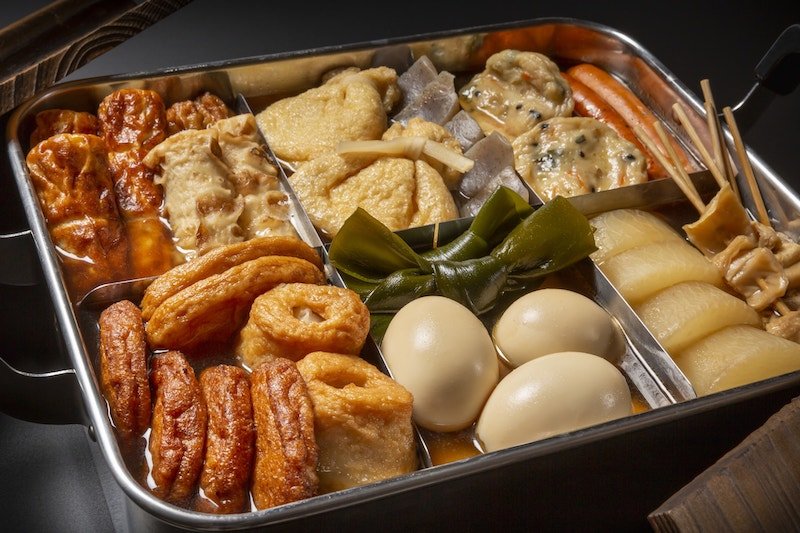Imagine a chilly, icy nighttime in Japan. The air is crisp, and you also find warmth in a steaming pot of Oden, a traditional Japanese fish cake stew. This comforting dish, simmered in a soy sauce-based totally dashi broth, has been a staple in Japanese families for many years. Oden isn’t simply food; it is an experience that brings families and pals together. Let’s learn about this loved dish’s wealth statistics and cultural importance.
Table of Contents
Ingredients and Preparation
At the coronary heart of Oden are its fresh, exquisite additives. Essential elements embody fish cakes, daikon (a type of radish), konnyaku (a yam cake), and numerous one-of-a-kind additions like boiled eggs and tofu. Each element offers a unique texture and flavor, growing a harmonious mixture that is virtually both exciting and nourishing.
Preparing Oden starts with deciding on the best materials. Fish desserts, crafted from ground fish and starch, are available in diverse shapes and flavors. Daikon, recognized for its mild flavor and crunchy texture, absorbs the broth’s flavors superbly. Konnyaku, with its jelly-like consistency, affords a pleasing contrast. Together, those components form the foundation of a delicious Oden pot.
The Art of Simmering
Creating the ideal Oden broth is an artwork in itself. The dashi broth, crafted from kombu (kelp) and bonito flakes, serves due to the fact of the bottom. This umami-wealthy liquid is more applicable with soy sauce, mirin, and sake, balancing savory and candy notes.
Soak the kombu in water and bring it to a mild simmer. Once the water is warm but no longer boiling, put off the kombu and add bonito flakes. Simmer for a few minutes, then strain the liquid to create a clear, fragrant broth. Add soy sauce, mirin, and sake, adjusting the flavors to your choice.
Simmering the components is essential. Start with the harder vegetables, like daikon and potatoes, allowing them to soak up the broth completely. Gradually add the fish desserts, tofu, and other sensitive gadgets, ensuring they do not overcook. The sluggish simmering process melds the flavors, resulting in a pot of Oden that is wealthy, savory, and heartwarming.
Serving and Enjoying Oden
Oden is historically served in a donabe clay pot, which keeps warmth well and is good for communal dining. This approach to serving encourages sharing, conversation, and a sense of togetherness.
When enjoying Oden, there is a certain etiquette to follow. It’s standard to ladle the broth and components into individual bowls, savoring each chunk slowly. Dip the fish cakes and greens into mustard or soy sauce for added flavor. The communal detail of eating Oden is just as critical as the dish itself, fostering a warm, inviting atmosphere.
Oden Variations Across Japan
One of the most delightful elements of Oden is its nearby versions. Each part of Japan adds its unique twist, incorporating local additives and flavors. In Tokyo, for instance, you may discover Oden with a mild, soy-based broth, while in Kansai, the broth is darker and richer.
Hokkaido’s Oden frequently includes seafood like squid and crab, reflecting the region’s coastal bounty. In assessment, Nagoya’s model might function as a completely miso-based broth, with a deep, savory complexity. These regional differences spotlight the versatility of Oden and the numerous culinary traditions of Japan.
Health Benefits of Oden
Oden is not only delicious but also full of dietary blessings. Fish cakes offer a super source of protein, while daikon and other veggies offer vital vitamins and minerals. Konnyaku is low in energy and excessive in fiber, helping digestion and creating a feeling of fullness.
The broth, rich in kombu and bonito flakes minerals, helps with normal fitness. The aggregate of components makes Oden a balanced meal that is certainly both pleasant and useful. It’s a first-rate addition to a healthful diet, specifically during the chillier months when a heat, nourishing dish is most welcome.
Where to Enjoy Oden in Japan
If you find yourself in Japan during the wintry weather, looking for pleasant Oden eating places is a must. In Tokyo, famed spots like Otafuku and Oden Yatai in Yurakucho provide the right enjoyment. These establishments have perfected their recipes for decades, supplying a flavor of life in every bowl.
Kyoto’s Nishiki Market is another super vacation spot, where you can buy Oden from numerous vendors. Each stall offers its particular take, allowing you to explore one-of-a-kind flavors and mixtures. Whether in a moderate-cease restaurant or a humble avenue stall, Oden brings warm temperatures and pleasure.
Conclusion
Oden is more than just a stew; it’s a symbol of Japanese lifestyle and subculture. Its rich records, numerous ingredients, and communal serving style create a dish that is both comforting and unifying. Whether you’re a pro Japan lover or new to its culinary delights, Oden offers a nourishing revelry that warms the body and soul.
Ready to discover the sector of Oden further? Delve into our encouraged recipes, visit top-rated Oden spots, or be a part of a cooking class to master the paintings of this cherished dish. The tradition of Oden awaits you—satisfied simmering!







